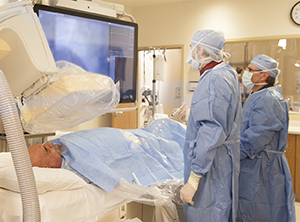Carotid Angiography
Carotid angiography is a type of X-ray test. It is done to see the inside (lumen) of the carotid arteries. These are the large blood vessels on the sides of your neck. They supply your brain with blood.
The test is done with a thin, flexible tube (catheter). It's passed into an artery in the leg or arm that leads to the carotids. Contrast dye is injected into the catheter. The dye makes it easier to see the carotids on X-rays.

Risks
Talk with your healthcare provider about the risks and possible complications of angiography.
How do I get ready for a carotid angiography?
Tell your healthcare provider:
-
About your past or current health conditions
-
Any allergies you have, including allergy to contrast dye
-
If you're pregnant or think you could be
-
If you're breastfeeding
Also tell your provider about all the medicines you take. You may be told to stop taking some or all of them before the test. Tell your provider if you use any of these:
-
Prescription medicines, including diabetes medicines or blood thinners
-
Over-the-counter medicines, including ibuprofen
-
Vitamins, herbs, kelp, seaweed, cough syrups, and supplements
-
Any illegal drugs
And make sure to:
-
Follow all directions for not eating or drinking before the test.
-
Swallow any medicines your provider says to take, using small sips of water.
-
Arrange for an adult family member or friend to drive you home.
What happens during carotid angiography?
-
An IV (intravenous) line is started in your arm. You may also be given a medicine that helps you relax (sedative).
-
You’re given an injection to numb the site where the catheter will be inserted. This is often in the groin area.
-
A small hole (puncture) is made into the artery. Then the catheter is inserted. Using X-rays, the catheter is then carefully guided through the arteries in your body into where the carotid artery starts in your neck.
-
Contrast dye is injected through the catheter into the artery. You may feel warmth, a metallic taste, or pressure in your legs, back, neck, or head. You'll need to lie still as X-rays are taken of the carotids. You may be asked to hold your breath during injections.
-
When the test is done, the catheter is removed.
-
If a closure device is used in the leg blood vessel, a sterile dressing will be put over the site. If manual pressure is used, a healthcare provider will hold pressure on the site. This is so that a clot will form. It closes off the small hole in the artery. Once the bleeding has stopped, a tight bandage will be placed on the site.
What happens after carotid angiography?
-
You will be taken to a recovery area.
-
You will then need to lie flat for a few hours.
-
Your healthcare provider will discuss the results with you after the procedure.
-
Depending on your test results and your medical condition, you will either be discharged home or stay in the hospital.
Once you are home:
-
Don’t drive for 24 hours or as advised by your provider.
-
Don't walk, bend, lift, or take stairs for 24 hours or as advised by your provider.
-
Don't lift anything over 5 pounds for 7 days.
Follow all other instructions from your provider.
When to call the healthcare provider
Call your healthcare provider if you have any of these:
-
Fever of 100.4°F (38°C) or higher, or as advised by your provider
-
Chills
-
Bleeding, swelling, or a lump at the insertion site
-
Sharp or worse pain at the insertion site
-
Feeling dizzy or lightheaded
-
Leg pain, numbness, or a cold leg or foot
-
Any other symptoms as advised by your provider
Call 911
Call 911 right away if you have any of these:
-
Severe headache
-
Vision problems
-
Trouble speaking
Online Medical Reviewer:
Marianne Fraser MSN RN
Online Medical Reviewer:
Raymond Turley Jr PA-C
Online Medical Reviewer:
Shaziya Allarakha MD
Date Last Reviewed:
2/1/2024
© 2000-2025 The StayWell Company, LLC. All rights reserved. This information is not intended as a substitute for professional medical care. Always follow your healthcare professional's instructions.